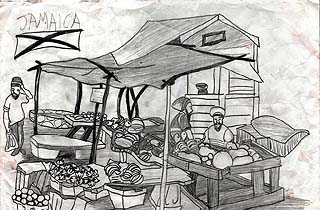|
 A Community Battered by Disaster The town of Swift River in Portland Parish, Jamaica, was once
one of the most thriving communities in the parish. During the
early years of the twentieth century and up to 1937, it was a
flourishing inland market town, with groceries, dry goods stores,
butcher shops, vegetable market, pharmacy, gas station, tailoring
establishment and other communal facilities such as a police
station, a post office, an "A" Grade elementary school
and six churches representing different denominations.  Small farmers in Swift River and the surrounding communities contributed to the lucrative banana industry that Portland then enjoyed. The United Fruit Company (UFCo) had banana plantations at Paradise and Shrewsbury; and at Hope Bay, on the coast, some four miles away, was one of the busiest trans-shipment stations in the parish. Along with such villages as Fruitful Vale, Swift River did well in the banana trade. Supplementing the UFCo's fleet of six trucks, Swift River truckers operated some seven vehicles, seven days a week, hauling bananas to Hope Bay where the fruit was off-loaded onto railway carriages for transportation to the Port Antonio docks. It was a time of prosperity. Then disaster struck. Commencing on the morning of 21st November and throughout the night, a cloudburst deposited 24 inches of rain in 24 hours. The Swift River and its tributaries broke their banks, destroying arable lands and houses in their path. Some 30 persons lost their lives. Hundreds were left homeless. Houses, shops, churches were washed away. The torrential rains were not confined only to Swift River as a massive landslide resulting from these rains also destroyed the community of Millbank in the east of the parish. Three major bridges linking Swift River with Hope Bay and other coastal communities were destroyed. But more was to follow. Two other floods struck in 1940 and again in 1943, thereby completing the havoc caused in 1937. Government put in place a massive relocation programme, resettling
many on the surrounding hills at New Eden and Bellvue but it
was several years before the major bridge across the Swift River
at Eden was restored. Without proper access to markets, Swift
River languished. Then to add to the catalogue of misfortunes,
the hurricanes of 1944 and 1951 devastated the little that Swift
River and the surrounding communities had tried to restore after
1937. Small farmers in Swift River and the surrounding communities contributed to the lucrative banana industry that Portland then enjoyed. The United Fruit Company had banana plantations at Paradise and Shrewsbury; and at Hope Bay, on the east coast, some four miles away, was one of the busiest trans-shipment stations in the parish. Along with such villages as Fruitful Vale, Swift River did well in the banana trade. Supplementing the UFCo's fleet of six trucks, Swift River truckers operated some seven vehicles seven days a week, hauling bananas to Hope Bay where the fruit was off-loaded onto railway carriages for transportation to the Port Antonio docks. It was a time of prosperity. Then disaster struck. On 30th November 1937, flood rains caused a massive landslide that destroyed the community at Millbank in the east of the parish and almost wiped out the Swift River community. Swollen by a cloudburst that deposited 24 inches of rain in 24 hours, the Swift River and its tributaries broke their banks, destroying arable lands and houses in their path. Some 30 persons lost their lives. Hundreds were left homeless. Houses, shops, churches were washed away. Three major bridges linking the community with the outside were destroyed. But more was to follow. Two other floods struck in November 1940 and again in November 1943, thereby completing the havoc caused in 1937. Government put in place a massive relocation programme, resettling many on the surrounding hills at New Eden and Bellvue but without ease of access to townships and markets on the coast, Swift River languished. Then to add to the catalogue of misfortunes, the hurricanes of 1944 and 1951 devastated the little that Swift River and the surrounding communities had tried to restore.
|